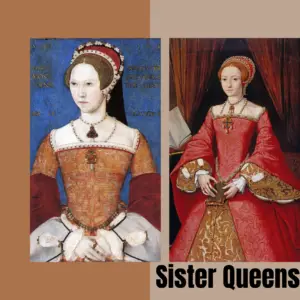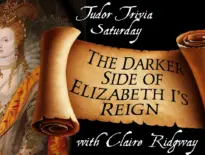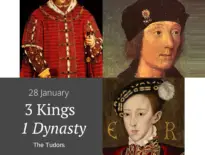 On 18th February 1516, Mary I of England was born, a Tudor princess who would go on to become England's first crowned queen regnant. To commemorate her birth, I want to explore the fascinating similarities and stark differences between Mary I and her half-sister, Elizabeth I.
On 18th February 1516, Mary I of England was born, a Tudor princess who would go on to become England's first crowned queen regnant. To commemorate her birth, I want to explore the fascinating similarities and stark differences between Mary I and her half-sister, Elizabeth I.
Both were daughters of Henry VIII, both were queens in their own right, and both faced incredible challenges. But while Mary’s reign lasted just five years, Elizabeth ruled for over 44 years, shaping what is often seen as England’s Golden Age.
So, what did these two queens have in common? And where did they differ?
Despite their different upbringings, religious views, and ruling styles, Mary and Elizabeth shared many traits.
- They Believed They Had an Absolute Right to Rule - Both women were fiercely convinced of their legitimacy and divine right to rule. As Henry VIII’s daughters, they believed their father had made them queens by God’s will, and they fought to defend their crowns. Mary I reclaimed her throne after what she saw as Lady Jane Grey’s usurpation in 1553. And Elizabeth I faced numerous plots against her, particularly from Mary, Queen of Scots, but she never wavered in her belief that she was England’s rightful ruler.
- They Fought for Their Throne (and Their Survival) - Neither sister simply inherited their throne without a fight. Mary had to rally support and ride into London in triumph to claim her crown, and she roused London against the rebels of Wyatt’s Rebellion in 1554. And Elizabeth faced threats throughout her reign, especially from Catholics who saw Mary, Queen of Scots as the rightful queen, and later from Spain, the Spanish Armada. Both women showed incredible resilience and courage in defending their positions.
- They Were the First Two Official Queens Regnant of England - Both Mary and Elizabeth made history as England’s first crowned queens regnant—a huge challenge in a world where women were not expected to rule. They faced sexism, doubt, and pressure to marry, yet both proved that a woman could rule England.
- They Were Married to the State - While Mary physically married Philip of Spain, politically, both women were "married" to their country: Mary saw herself as married to Catholicism and her duty to restore England to Rome. And Elizabeth, famously, never married, declaring herself the Virgin Queen, saying she was married to her realm and her people.
- They Built Up England’s Navy - Both queens recognised the importance of a strong navy. Mary expanded naval funding, laying the groundwork for future successes. And Elizabeth took it even further, leading to the navy’s victory against the Spanish Armada in 1588.
- They Inspired Loyalty and Had Close-Knit Households - Both Mary and Elizabeth struggled for acceptance within their own families but found love and loyalty in their households. Both surrounded themselves with trusted courtiers, and both had people who remained devoted to them even in the darkest of times.
- They Could Be Both Merciful and Vengeful - Despite being remembered differently, both sisters showed mercy and ruthlessness when necessary. Mary executed Lady Jane Grey, even though she was reluctant to do so. Elizabeth eventually executed Mary, Queen of Scots, after years of hesitation. Both women faced immense pressure from their advisors to eliminate threats—something they both tried to resist but ultimately did.
- They Had the Tudor Temper - Both Mary and Elizabeth inherited their father’s legendary Tudor temper. Mary could be stubborn and uncompromising, particularly when it came to religion. Elizabeth was volatile and passionate, and could lash out at her council and her ladies when displeased. They could be commanding, unpredictable, and fiery—just like Henry VIII.
- They Enjoyed Courtly Pleasures - Despite their responsibilities, both queens loved: music and dancing, elegant clothing, spectacles and courtly entertainments, blood sports and gambling. They were Tudors through and through when it came to the finer things in life.
While Mary and Elizabeth shared many traits, their differences shaped history.
- Their Approach to Religion - Perhaps the biggest difference between them was their faith: Mary was a devout Catholic, determined to restore England to Rome, even if it meant persecution. Elizabeth was a Protestant, but more flexible, focusing on political stability rather than religious dogma. Mary put religion before England, whereas Elizabeth put England before religion. However, it shouldn’t be forgotten that there was religious persecution in Elizabeth’s reign too.
- Their Political Styles - Mary was more direct and conventional, trusting those who shared her faith. Elizabeth was enigmatic and pragmatic, playing politics masterfully. Elizabeth was a shrewd politician, while Mary appears to have been less politically savvy and more idealistic.
- Their Councils and Advisors - Mary had a larger council, but many of her advisors failed her, particularly in her marriage to Philip of Spain. Elizabeth ruled with a smaller, highly skilled council, relying on men like William Cecil and Francis Walsingham. Elizabeth’s choice of advisors was key to her success, while Mary’s council struggled to unite behind her.
- Their Marital Status - Mary married Philip of Spain, but it was deeply unpopular in England. Elizabeth never married, using her single status as a political tool. Mary saw marriage as essential to producing an heir, while Elizabeth saw it as a potential trap.
- How They Dealt With Their Successors - Mary was desperate for a child but was unable to conceive. She refused to name Elizabeth as her heir until the last moment. Elizabeth never had children but accepted James VI of Scotland as her successor. Mary fought to continue the Tudor line, while Elizabeth was more accepting of change.
- Their Reputation and Legacy - Mary’s reign is often remembered for the Marian persecutions—burning Protestants and failing to produce an heir. Elizabeth’s reign is seen as a Golden Age, remembered for defeating the Spanish Armada, exploration, and cultural growth. History has been far kinder to Elizabeth than to Mary, even though both women shaped England in profound ways.
Mary I and Elizabeth I were two sides of the same Tudor coin—strong-willed, intelligent, and determined. But where Mary’s devotion to Catholicism and her marriage to Philip of Spain undermined her rule, Elizabeth’s political cunning, flexibility, and refusal to marry made her one of the most successful monarchs in English history.
So, was Elizabeth really England’s greatest queen? Or is Mary I’s reign unfairly overshadowed?



Leave a Reply